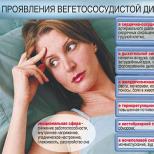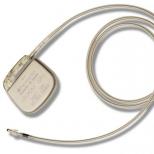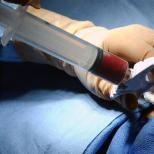How to cope with an attack of vegetative vascular dystonia
Vegetative-vascular dystonia is a very popular diagnosis of our time. According to some reports, about 80% of the population suffers from it, but only a third of them bring serious inconvenience. The symptoms of this disease overlap with other very dangerous diseases, and therefore, in matters of diagnosing VVD (vegetative-vascular dystonia), especially when there is an exacerbation of the disease, one should rely on the results of a comprehensive examination. Doctors believe that VVD should be considered as a complex of symptoms of cardiovascular disorders that affect the autonomic nervous system.
The control of the autonomic nervous system is beyond the control of human consciousness and functions independently. The importance of her work cannot be overestimated. It regulates homeostasis (balance) of the internal environment of the body.
There are two main functions that this system performs:
- maintains the stability of blood pressure, respiratory rate, body temperature and other significant data of the internal environment of the body;
- promotes adaptation to environmental conditions, tk. activates the body systems in time for an adequate response.
The autonomic nervous system also controls the activity of the cardiovascular system. Depending on the activity of the body, the vessels expand and contract. This is due to the interaction of the sympathetic and parasympathetic systems. With VSD, there is a discord in the interaction of these systems and there are often cases when, instead of an adequate response to external changes, unpredictable reactions occur. For example, darkening in the eyes when bending over. Women are three times more likely to suffer from this disease.
VVD attack
A sudden failure in the autonomic nervous system, which entails disharmony in the work of the organs and systems of the body, is an attack of the VSD. Symptoms of an attack negatively affect the general condition of a person.
Causes of VVD
The causes that cause exacerbation of the VSD are not much different from the causes that cause vegetative-vascular dystonia. We list the main ones:
- stress and excessive emotional stress;
- spinal column injuries;
- strokes, brain injuries, tumors;
- endocrine diseases (thyroid gland, sex glands, adrenal glands);
- heredity, birth trauma;
- hormonal changes in the body.
In most cases, there is a combination of several causes. Given their interconnectedness, it is difficult to draw conclusions about the specific cause of the disease.
Seizure symptoms
The manifestations of a crisis depend on its severity. Some people have some symptoms more pronounced than others. Symptoms of vegetative-vascular dystonia are poorly expressed in individuals with concomitant vascular diseases. Symptoms of vegetative-vascular dystonia have much in common with the symptoms of other more serious diseases. Therefore, some doctors often make mistakes in making a diagnosis, which can adversely affect the future health of patients.
 Pain. Localization of pain sensations usually falls on the subscapular region, left arm and forearm. The nature of the pain varies from dull, squeezing to tingling. In favor of the attack is the fact that the pain is quickly passing and that earlier, during the examination, no problems with the heart were found. Heart pain during an attack indicates physical and emotional overload.
Pain. Localization of pain sensations usually falls on the subscapular region, left arm and forearm. The nature of the pain varies from dull, squeezing to tingling. In favor of the attack is the fact that the pain is quickly passing and that earlier, during the examination, no problems with the heart were found. Heart pain during an attack indicates physical and emotional overload.
Headache can appear more than once a day for several months. It happens that after a six-month break, the pain returns again. The first ten minutes of pain during an attack are characterized by such external signs:
- increased sweating;
- tearing and redness of the eyes;
- drooping eyelids;
- flushing (redness) of the face.
This condition is observed in males aged 20 to 30 years who have bad habits.
In hot weather, attacks are especially difficult. The above symptoms may include the following: nausea, weakness, dizziness, lowering or increasing blood pressure, palpitations, shortness of breath, nausea, weakness, fainting, hearing loss and vision loss. This condition can easily develop into a panic attack.
A panic attack is characterized by lightning speed of development, duration of a couple of hours, an increase in a sense of fear, turning into a panic. To the listed symptoms are added: panic, fever, fear of death, sleep disturbance, fatigue.
Crises vsd
The most prominent manifestation of VSD is panic attack syndrome. The cause that caused an attack of VSD may be physical, emotional overload, poisoning, a violation of the usual daily routine. The mechanism of occurrence of the crisis is explained by the increased concentration of biologically active substances in the body: steroid hormones, adrenaline, acetylcholine. Depending on the substance contained in excess and the specific characteristics of each organism, the manifestations of the crisis may be different.
|
Name of the crisis |
Manifestations |
|
Symptomatic-adrenaline |
Characterized by unpleasant sensations in the head and heart, increased blood pressure, increased heart rate, cold extremities, chills may be observed. The patient experiences excitement, anxiety, anxiety, developing into fear. |
|
hyperventilating |
An increase in pressure is observed, the respiratory rate increases, the patient feels a lack of air, the tension of the muscles of the hands, feet, legs, and forearms. There is tachycardia. |
|
Vagoinsular |
A distinctive feature of the onset of an attack is general weakness, after which nausea, lack of air, dizziness appear. External manifestations: lowering blood pressure, sweating, sometimes vomiting. Relief occurs when the patient takes a horizontal position. |
|
Vegetative-vestibular |
Such an attack of VSD usually occurs with a sharp change in the position of the body or head. Characterized by a sharp onset, accompanied by vomiting, nausea and dizziness. During the acute period of an attack, blood pressure fluctuates greatly |
Depending on the severity of the case, the duration of the attack will be different. So, in mild cases, it lasts from several minutes to an hour, of moderate severity - from 2 to 4 hours, in severe cases - up to 6-8 hours. In some cases, the duration of the attack can be several days. If a crisis occurs, then first aid should be aimed at relieving symptoms.
Rules for overcoming an attack
- Psychological rest. During an attack, it is first of all recommended to calm down and not panic, because. otherwise, the crisis will worsen.
- Physical rest. It is necessary to lie down, giving the legs an elevated position, thus ensuring the flow of blood to the brain. the room must be provided with fresh air.
- Medicines. You can take 20 drops of corvalol or valocordin dissolved in water. In case of deterioration of the condition, it is worth resorting to a stronger remedy - gidazepam, putting half a tablet under the tongue.
- Warm foot bath. Dip your feet in warm water to the ankles.
Poorly rendered first aid can cause a new, more protracted crisis.
Treatment
An attack of VSD is a disease that must be treated in accordance with the doctor's prescriptions. First aid involves the use of drugs that have a calming and stimulating effect. These remedies include: valocordin, tinctures of valerian, motherwort, eleutherococcus, peony, Schisandra chinensis. Any of these tinctures should be used as follows: 50 gr. tinctures are dissolved in half a glass of water. Light pressure on the eyeballs for a minute will help relieve a strong heartbeat. Warm showers and baths can help lower blood pressure and relieve stress.
An interesting video about simple ways to deal with the VSD crisis
During a panic attack, the main thing is not to succumb to anxiety. You can drink a sedative. Doctors recommend to lie down and distract from unpleasant thoughts.
Prevention
To prevent a recurrence of the crisis, the following requirements must be followed:
- Do not stay in the sun for a long time in the hot season, even with a hat. In summer, always have water and a hat with you;
- Have a sedative (valerian, motherwort) with you, which should be used at the very beginning of an attack;
- Rational combination of work and rest. Sleep duration - at least 8 hours;
- moderate exercise;
- Proper nutrition (avoid fried, pickled);
- Massage the head, back and neck area.
Treatment of VVD should be carried out by an experienced doctor, because. unsystematic self-treatment with sedatives is addictive and can poorly relieve the symptoms of vegetative-vascular dystonia.





